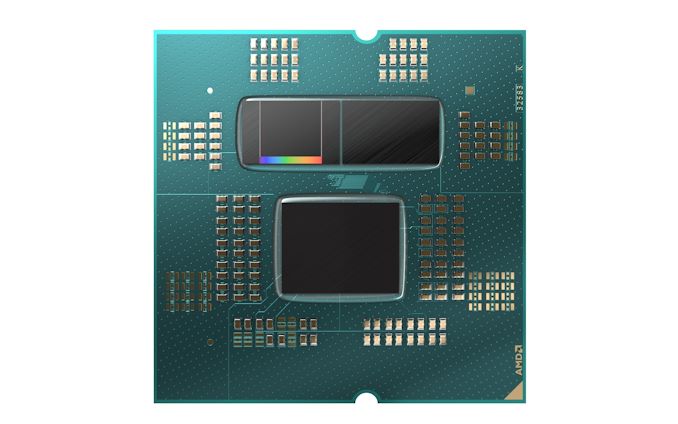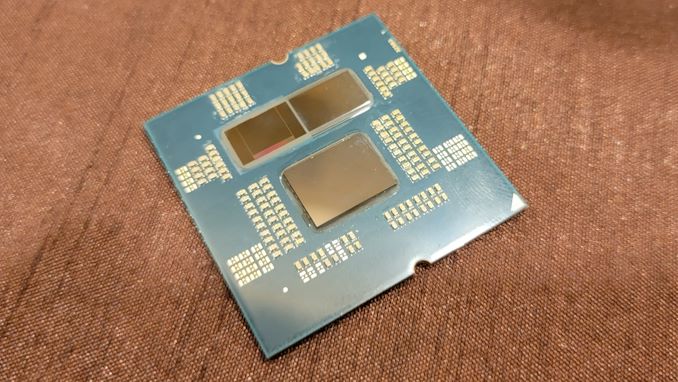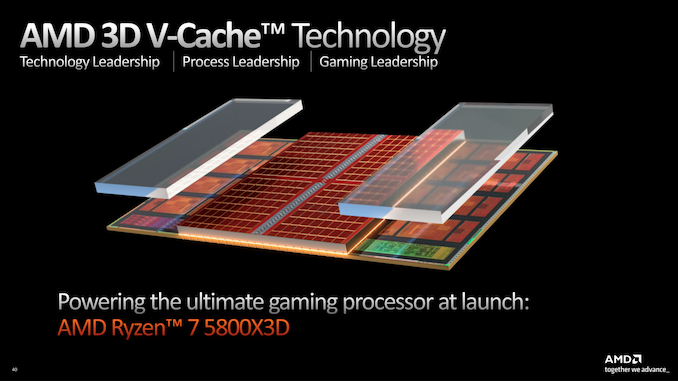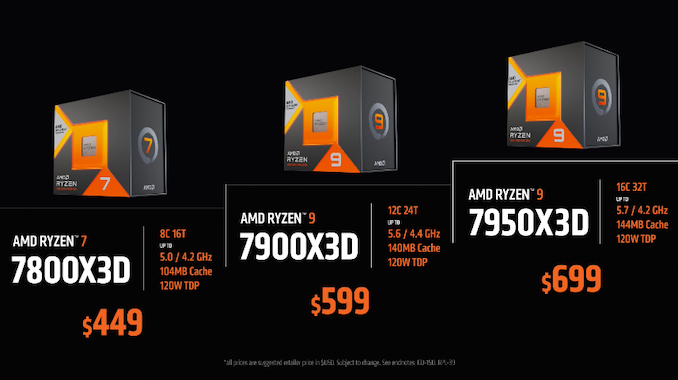AMD’s Ryzen 7000X3D Chips Get Release Dates: February 28th and April 6th, For $699/$599/$449
by Ryan Smith on February 1, 2023 9:45 PM EST- Posted in
- CPUs
- AMD
- X3D
- Ryzen 7000
- Raphael
- 3D V-Cache

AMD today has announced the launch date and prices for its eagerly anticipated Ryzen 7000X3D series processors. Aimed primarily at gamers, the company’s first L3 V-Cache equipped Ryzen 7000 processors will begin rolling out on February 28th, when the Ryzen 9 7950X3D and Ryzen 9 7900X3D go on sale for $699 and $599 respectively. This will be followed up by the Ryzen 7 7800X3D a bit over a month later, when it goes on sale for $449 on April 6th.
First announced to great fanfare during AMD’s CES 2023 keynote (and teased well before that), the Ryzen 7000X3D chips will be AMD’s second generation of consumer chips employing the company’s novel 3D stacked V-Cache technology. V-Cache allows AMD to stack a 64MB L3 cache die on top of their existing CCDs in order to expand the total L3 capacity of a Zen 3/4 CCD, going from 32MB to 96MB. And in the case of multi-CCD designs such as the Ryzen 9 7950X, bringing the total, chip-wide L3 cache pool to 128MB.
| AMD Ryzen 7000X/X3D Series Line-Up | |||||||
| AnandTech | Cores Threads |
Base Freq |
Turbo Freq |
L3 Cache |
TDP | Price (Street) |
Release Date |
| Ryzen 9 7950X3D | 16C / 32T | 4.2 GHz | 5.7 GHz | 128 MB | 120W | $699 | 02/28/23 |
| Ryzen 9 7950X | 16C / 32T | 4.5 GHz | 5.7 GHz | 64 MB | 170W | $583 | - |
| Ryzen 9 7900X3D | 12C / 24T | 4.4 GHz | 5.6 GHz | 128 MB | 120W | $599 | 02/28/23 |
| Ryzen 9 7900X | 12C / 24T | 4.7 GHz | 5.6 GHz | 64 MB | 170W | $444 | - |
| Ryzen 7 7800X3D | 8C / 16T | 4.2 GHz | 5.0 GHz | 96 MB | 120W | $449 | 04/06/23 |
| Ryzen 7 7700X | 8C / 16T | 4.5 GHz | 5.4 GHz | 32 MB | 105W | $299 | - |
| Ryzen 7 5800X3D | 8C / 16T | 3.4 GHz | 4.5 GHz | 96 MB | 105W | $323 | - |
Following the successful trial of the technology in the consumer space with AMD’s original Ryzen 7 5800X3D, which was released to positive acclaim back in the spring of 2022, AMD has developed a much broader lineup of V-Cache equipped Ryzen chips for this generation. This includes not only the 5800X3D’s direct successor, the 8 core Ryzen 7 7800X3D, but also, for the first time, chips employing multiple CCDs. These are the Ryzen 9 7900X3D and 7950X3D, which will offer 12 and 16 CPU cores, respectively.
Interestingly, AMD has gone for a non-homogenous design for these multi-CCD parts – rather than giving both CCDs V-Cache, AMD is only outfitting one of the CCDs with the extra L3 cache. The other CCD will remain a plain Zen 4 CCD, with its integrated 32MB of L3 cache. The unbalanced design, besides allowing AMD to control the costs of what’s still a relatively expensive technology to implement, will allow AMD to offer something close to the best of both worlds for their multi-CCD parts. The V-Cache equipped Zen 4 CCDs will offer 6 or 8 CPU cores backed by the massive L3 pool, for tasks that benefit from the larger cache size, while the vanilla Zen 4 CCDs will be unencumbered by the V-Cache, allowing them to clock higher for pure throughput workloads that wouldn’t benefit from the extra cache.
As with the original 5800X3D, AMD is aiming these chips at gamers in particular, as the complex, heavy-dataset nature of video games means they often benefit from having additional L3 cache on-hand. The 5800X3D was, depending on the game, around 15% faster than its vanilla Ryzen counterpart – at least so long as it wasn’t GPU limited. AMD is being a bit more coy this time around on making apples-to-apples comparisons against their regular Ryzen 7000 chips, so for now the only official performance figures available from AMD are pitting the chips against the 5800X3D. In lieu of that, a 15% improvement is a reasonable baseline given that the cache sizes haven’t changed in the last generation, but we’ll definitely want to take a closer look at the final chips to see if the additional L3 cache is as beneficial to Zen 4 as it was for Zen 3.
Back at their CES 2023 keynote, AMD announced the specifications for two-and-a-half of the chips, as well as an undetailed February launch date. With today’s announcement, AMD is finally filling in the rest of the details, as well as confirming that only part of the product stack is going to make that February launch date.

(Image Courtesy Tom's Hardware)
As previously noted, the Ryzen 9 7950X3D and Ryzen 9 7900X3D both launch on February 28th. The 16 core 7950X3D will hit the streets with a $699 price tag, while the 12 core 7900X3D will intro at $599. At current street prices, this represents roughly a $100 to $150 premium over the chips’ regular counterparts, with the 7950X selling for around $583, and the 7900X selling for around $444. Prices on AMD’s top AM5 chips have come down a decent bit since their 2022 launch, so the new X3D SKUs are coming in at similar launch prices as their non V-Cache counterparts. Put another way, whereas $699 would get you a 16 core 7950X in September, come February it will get you the same chip with an additional 64MB of L3 cache.
Other than benchmarks, at this point the only detail we don’t have on the 7950X3D and 7900X3D are the clockspeeds for the V-Cache equipped CCDs. AMD’s quoted turbo clockspeeds are for the vanilla CCD, so it’s unclear just how much clockspeeds have been lowered for the V-Cache CCD. But taking a hint from AMD’s sole single CCD X3D part, the 7800X3D, we see that part has a top clockspeed of just 5.0GHz. So we’d expect something similar for the V-Cache CCDs on the Ryzen 9 parts.
Speaking of the Ryzen 7 7800X3D, we finally have the full specifications on AMD’s most straightforward X3D part. Back in January AMD hadn’t locked down the base clockspeeds on this part, but as of today we finally have the answer: 4.2GHz. The chip will, in turn, be able to turbo as high as 5.0GHz as previously noted.
The cheapest of the Z3D parts, with a price tag of $449, the 7800X3D will also be the laggard of the group, with the chip not launching until April 6th. AMD has not explained the gap in launch dates, but it’s reasonable to assume that AMD is prioritizing the assembly and shipping of their more expensive Ryzen 9 SKUs. In any case, at current street prices the 7800X3D will carry a $150 premium over the $299 7700X, making it a full 50% more expensive, assuming these street prices hold through April. This happens to be the same price the 5800X3D launched at, so AMD is technically just holding the line here, but it does underscore how price cuts on the rest of the Ryzen 7000 lineup have made the standard chips very competitive on a price/performance basis.
In any case, we’ll have more on AMD’s first V-Cache equipped Zen 4 chips later this month. Besides taking an in-depth look at the performance improvements brought about by the larger L3 cache, the other major factor driving performance is going to be the Windows thread scheduler. As this is AMD’s first asymmetric Ryzen CPU, it will be up to Windows and AMD’s chipset driver to figure out which CCD to place threads on for the 7950X3D/7900X3D. So this month’s launch is going to require that AMD’s hardware and software offerings are in sync in order for the company to make a good first impression.












64 Comments
View All Comments
nandnandnand - Thursday, February 2, 2023 - link
Probably true, or AMD wouldn't do it, but it still needs to be confirmed by reviews.Intel going first with even more asymmetric CPUs probably helped lay the groundwork.
James5mith - Thursday, February 2, 2023 - link
Why are base clock speeds so RF#$*() high these days?Why not run at 1-2GHz and keep power consumption to an absolute minimum until needed?
Glaurung - Thursday, February 2, 2023 - link
They do. My old 3ghz cup runs at something like 800mhz whenever the system is idle or mostly idle. The "base" clock speed is what you are guaranteed to get when you ask the CPU to do work. When you're not asking it to do work, it idles at a fraction of that. The turbo clock speed is not guaranteed - you get it only if parameters (mostly heat, but also esoterica like power demands and the speed of the other cores) are not exceeded.meacupla - Thursday, February 2, 2023 - link
They don't. Desktop ryzen chips have a rather high power draw when they are idle, because they don't bump down below 1ghz.Unless there is some discrepency in how low the multiplier goes on X, X3D, G, and regular chips?
As for why AMD doesn't have a more aggressive idle? IDK. Their laptop ryzen parts can do low idle of 800Mhz, so there really should be no reason for the very high idle clocks of desktop ryzen, unless there is some kind of software or hardware power delivery issue.
brantron - Thursday, February 2, 2023 - link
I disable that on both my Tigerlake Surface and Skylake XPS 13 because it does not change idle power even 0.1w or the temperature 1 degree.They are always 2.4 to 3 GHz and it's much more likely I see 4+ GHz that way doing normal things. I can set the Surface as high as 3.8 GHz minimum, and it still doesn't matter, even though it's fanless.
Just leave the C states alone, and it will run at a very low voltage and gate whatever isn't in use. CPUs have been able to run around 4 GHz at 1.0v or less for years. It wasn't long ago that 0.9v was for the 800 MHz lowest power state.
Many laptops overdo it and hang around the high latency power states. It's like they're stuck in battery saver mode, but while plugged in.
Go to a store with different laptops on display, set them to the high power profile, and watch how the 4 to 5 GHz i7s and Zen 3s stay closer to 3 GHz.
Desktops have no use for that, so it isn't supported.
The difference with some AMD desktop CPUs is that the separate controller chip does not have the same fine grain power control. Some use 10 watts minimum, which may add up to 20+ for the CPU package because of BIOS settings.
Supposedly Zen 4 addressed that by making the controller chip more like the Zen 3+ system on a chip. It remains to be seen if the Dragon Range laptops use the same chips.
meacupla - Thursday, February 2, 2023 - link
Okay, so since you don't seem to understand that the desktop and laptop parts are not comparable, here is the gist of it.Intel laptop CPUs have very poor idle power draw
Intel desktop CPUs have good idle power draw
AMD laptop CPUs/APUs have good idle power draw
AMD desktop CPUs have poor idle power draw
Ryzen desktop CPU idle is so bad, that it can pull twice the wattage at the wall when compared to Intel desktop CPUs
On the other hand, Intel laptop CPUs implemented efficiency cores, and they still can't keep up with how efficient Ryzen laptop CPUs are.
Ryzen controller on Ryzen laptop CPUs will have a measurable difference in results.
JasonMZW20 - Thursday, February 2, 2023 - link
AMD’s desktop cores using CPPC2 don’t report lower clocks because they’re sleeping; desktop parts should report about 3.6-3.7GHz, but are actually off. If you see something like 1700MHz at idle, CPPC2 has been disabled in power plan and CPU has reverted to legacy P-states. Only Ryzen Master can show true core info.As for the high idle draw on desktop parts, that’s mostly a consequence of having chiplets and needing to keep PHYs powered for IOD/CCD communication. This is also why laptop parts are power sippers: they’re monolithic, so more hardware can be power-gated.
abufrejoval - Sunday, February 19, 2023 - link
I was going to post something like "your tool is reading it wrong", need to use Ryzen Master to check core clocks, but you've done it much better ;-)Golgatha777 - Thursday, February 2, 2023 - link
I'm feeling pretty good about taking Micro Center up on their ASUS ROG B650E-F, 32GB DDR5 6000, and 7900X for $599 deal. I'll wait for the price reductions and do UEFI updates in the meantime to be ready for a drop-in replacement somewhere down the line once all the bugs are worked out.nandnandnand - Saturday, February 4, 2023 - link
Wait for Zen 5 X3D or something.